- ISBN
- Author(s)
- Language
- Publisher
- Edition
- Edition
General Chemistry notes
Darrell Ebbing, Steven D. Gammon - ISBN: 9781305887299
- ISBN
- Author(s)
- Language
- Publisher
- Edition
- Edition
View all 27 notes for General Chemistry, written by Darrell Ebbing, Steven D. Gammon. All General Chemistry notes, flashcards, summaries and study guides are written by your fellow students or tutors. Get yourself a General Chemistry summary or other study material that matches your study style perfectly, and studying will be a breeze.
Best selling General Chemistry notes
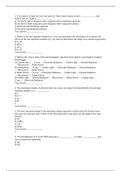
This is a practice chemistry final exam . Questions only
- Exam (elaborations)
- • 10 pages •
This is a practice chemistry final exam . Questions only
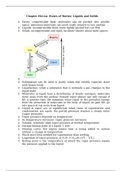
Description of States of Matter
- Textbook notes
- • 3 pages •
Description of States of Matter
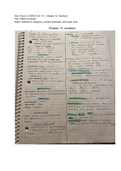
Gen Chem 2 CHEM112 & 113 : Chapter 12: Solutions Penn State University Notes, definitions, diagrams, practice examples, and exam prep
- Class notes
- • 8 pages •
Gen Chem 2 CHEM112 & 113 : Chapter 12: Solutions Penn State University Notes, definitions, diagrams, practice examples, and exam prep
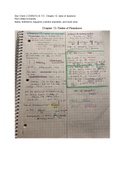
Gen Chem 2 CHEM112 & 113 : Chapter 13: rates of reactions Penn State University Notes, definitions, diagrams, practice examples, and exam prep
- Class notes
- • 25 pages •
Gen Chem 2 CHEM112 & 113 : Chapter 13: rates of reactions Penn State University Notes, definitions, diagrams, practice examples, and exam prep

Nuclear chemistry is the sub-field of chemistry dealing with radioactivity, nuclear processes, and transformations in the nuclei of atoms, such as nuclear transmutation and nuclear properties. ... An important area is the behavior of objects and materials after being placed into a nuclear waste storage or disposal site.Many entities can be involved in nuclear reactions. The most common are protons, neutrons, alpha particles, beta particles, positrons, and gamma rays.
- Class notes
- • 30 pages •
Nuclear chemistry is the sub-field of chemistry dealing with radioactivity, nuclear processes, and transformations in the nuclei of atoms, such as nuclear transmutation and nuclear properties. ... An important area is the behavior of objects and materials after being placed into a nuclear waste storage or disposal site.Many entities can be involved in nuclear reactions. The most common are protons, neutrons, alpha particles, beta particles, positrons, and gamma rays.

Activation energy, in chemistry, the minimum amount of energy that is required to activate atoms or molecules to a condition in which they can undergo chemical transformation or physical transport.The role of activation energy in a chemical reaction is to start the reaction by arranging the reactants appropriately and breaking their existing...
- Class notes
- • 16 pages •
Activation energy, in chemistry, the minimum amount of energy that is required to activate atoms or molecules to a condition in which they can undergo chemical transformation or physical transport.The role of activation energy in a chemical reaction is to start the reaction by arranging the reactants appropriately and breaking their existing...

In order to determine a rate law we need to find the values of the exponents n, m, and p, and the value of the rate constant, k. If we are given the reaction orders for a reaction, we have the values of the coefficients we need to write the rate law.Rate laws or rate equations are mathematical expressions that describe the relationship between the rate of a chemical reaction and the concentration of its reactants. In general, a rate law (or differential rate law, as it is sometimes called) takes...
- Class notes
- • 15 pages •
In order to determine a rate law we need to find the values of the exponents n, m, and p, and the value of the rate constant, k. If we are given the reaction orders for a reaction, we have the values of the coefficients we need to write the rate law.Rate laws or rate equations are mathematical expressions that describe the relationship between the rate of a chemical reaction and the concentration of its reactants. In general, a rate law (or differential rate law, as it is sometimes called) takes...
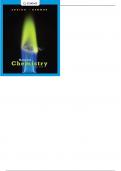
Test Bank For General Chemistry 11th Edition by Darrell Ebbing
- Exam (elaborations)
- • 1260 pages •
Test Bank For General Chemistry 11th Edition by Darrell Ebbing

Step 1: Convert temperatures from degrees Celsius to Kelvin. T = degrees Celsius 273.15. T1 = 3 273.15. ... Step 2 - Find Ea ln(k2/k1) = Ea/R x (1/T1 - 1/T2) ln(7.1 x 10-2/8.9 x 10-3) = Ea/8.3145 J/K·mol x (1/276.15 K - 1/308.15 K) ... Answer: The activation energy for this reaction is 4.59 x 104 J/mol or 45.9 kJ/mol.
- Class notes
- • 10 pages •
Step 1: Convert temperatures from degrees Celsius to Kelvin. T = degrees Celsius 273.15. T1 = 3 273.15. ... Step 2 - Find Ea ln(k2/k1) = Ea/R x (1/T1 - 1/T2) ln(7.1 x 10-2/8.9 x 10-3) = Ea/8.3145 J/K·mol x (1/276.15 K - 1/308.15 K) ... Answer: The activation energy for this reaction is 4.59 x 104 J/mol or 45.9 kJ/mol.
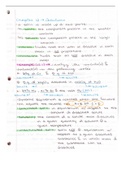
Hello! Need help with chemistry? These are my class notes from general chemistry II! These notes are divided into chapters that are covered within this course. Every chapter contains important definitions/concepts along with multiple example questions which can help you understand these concepts! Some example questions are completed with step-by-step solutions! Other example questions are left blank letting you try them out! General chemistry is tough but I am sure that with these notes you will...
- Class notes
- • 9 pages •
Hello! Need help with chemistry? These are my class notes from general chemistry II! These notes are divided into chapters that are covered within this course. Every chapter contains important definitions/concepts along with multiple example questions which can help you understand these concepts! Some example questions are completed with step-by-step solutions! Other example questions are left blank letting you try them out! General chemistry is tough but I am sure that with these notes you will...
Do you have documents that match this book? Sell them and earn money with your knowledge!
Newest General Chemistry summaries

The half-life of a reaction, t1/2, is the amount of time needed for a reactant concentration to decrease by half compared to its initial concentration. Its application is used in chemistry and medicine to predict the concentration of a substance over time.
- Class notes
- • 23 pages •
The half-life of a reaction, t1/2, is the amount of time needed for a reactant concentration to decrease by half compared to its initial concentration. Its application is used in chemistry and medicine to predict the concentration of a substance over time.

Reaction rate, in chemistry, the speed at which a chemical reaction proceeds. It is often expressed in terms of either the concentration (amount per unit volume) of a product that is formed in a unit of time or the concentration of a reactant that is consumed in a unit of time.
- Class notes
- • 16 pages •
Reaction rate, in chemistry, the speed at which a chemical reaction proceeds. It is often expressed in terms of either the concentration (amount per unit volume) of a product that is formed in a unit of time or the concentration of a reactant that is consumed in a unit of time.

Nuclear chemistry is the sub-field of chemistry dealing with radioactivity, nuclear processes, and transformations in the nuclei of atoms, such as nuclear transmutation and nuclear properties. ... An important area is the behavior of objects and materials after being placed into a nuclear waste storage or disposal site.Many entities can be involved in nuclear reactions. The most common are protons, neutrons, alpha particles, beta particles, positrons, and gamma rays.
- Class notes
- • 30 pages •
Nuclear chemistry is the sub-field of chemistry dealing with radioactivity, nuclear processes, and transformations in the nuclei of atoms, such as nuclear transmutation and nuclear properties. ... An important area is the behavior of objects and materials after being placed into a nuclear waste storage or disposal site.Many entities can be involved in nuclear reactions. The most common are protons, neutrons, alpha particles, beta particles, positrons, and gamma rays.

Collision theory, theory used to predict the rates of chemical reactions, particularly for gases. The collision theory is based on the assumption that for a reaction to occur it is necessary for the reacting species (atoms or molecules) to come together or collide with one another.There are three important parts to collision theory, that reacting substances must collide, that they must collide with enough energy and that they must collide with the correct orientation.
- Class notes
- • 31 pages •
Collision theory, theory used to predict the rates of chemical reactions, particularly for gases. The collision theory is based on the assumption that for a reaction to occur it is necessary for the reacting species (atoms or molecules) to come together or collide with one another.There are three important parts to collision theory, that reacting substances must collide, that they must collide with enough energy and that they must collide with the correct orientation.

Activation energy, in chemistry, the minimum amount of energy that is required to activate atoms or molecules to a condition in which they can undergo chemical transformation or physical transport.The role of activation energy in a chemical reaction is to start the reaction by arranging the reactants appropriately and breaking their existing...
- Class notes
- • 16 pages •
Activation energy, in chemistry, the minimum amount of energy that is required to activate atoms or molecules to a condition in which they can undergo chemical transformation or physical transport.The role of activation energy in a chemical reaction is to start the reaction by arranging the reactants appropriately and breaking their existing...

k is the first-order rate constant, which has units of 1/s. The method of determining the order of a reaction is known as the method of initial rates. The overall order of a reaction is the sum of all the exponents of the concentration terms in the rate equation.
- Class notes
- • 39 pages •
k is the first-order rate constant, which has units of 1/s. The method of determining the order of a reaction is known as the method of initial rates. The overall order of a reaction is the sum of all the exponents of the concentration terms in the rate equation.

The rate law is a differential equation, meaning that it describes the change in concentration of reactant(s) per change in time. Using calculus, the rate law can be integrated to obtain an integrated rate equation that links concentrations of reactants or products with time directly.
- Class notes
- • 23 pages •
The rate law is a differential equation, meaning that it describes the change in concentration of reactant(s) per change in time. Using calculus, the rate law can be integrated to obtain an integrated rate equation that links concentrations of reactants or products with time directly.

The rate law is a differential equation, meaning that it describes the change in concentration of reactant(s) per change in time. Using calculus, the rate law can be integrated to obtain an integrated rate equation that links concentrations of reactants or products with time directly.
- Class notes
- • 9 pages •
The rate law is a differential equation, meaning that it describes the change in concentration of reactant(s) per change in time. Using calculus, the rate law can be integrated to obtain an integrated rate equation that links concentrations of reactants or products with time directly.

In order to determine a rate law we need to find the values of the exponents n, m, and p, and the value of the rate constant, k. If we are given the reaction orders for a reaction, we have the values of the coefficients we need to write the rate law.Rate laws or rate equations are mathematical expressions that describe the relationship between the rate of a chemical reaction and the concentration of its reactants. In general, a rate law (or differential rate law, as it is sometimes called) takes...
- Class notes
- • 15 pages •
In order to determine a rate law we need to find the values of the exponents n, m, and p, and the value of the rate constant, k. If we are given the reaction orders for a reaction, we have the values of the coefficients we need to write the rate law.Rate laws or rate equations are mathematical expressions that describe the relationship between the rate of a chemical reaction and the concentration of its reactants. In general, a rate law (or differential rate law, as it is sometimes called) takes...

Step 1: Convert temperatures from degrees Celsius to Kelvin. T = degrees Celsius 273.15. T1 = 3 273.15. ... Step 2 - Find Ea ln(k2/k1) = Ea/R x (1/T1 - 1/T2) ln(7.1 x 10-2/8.9 x 10-3) = Ea/8.3145 J/K·mol x (1/276.15 K - 1/308.15 K) ... Answer: The activation energy for this reaction is 4.59 x 104 J/mol or 45.9 kJ/mol.
- Class notes
- • 10 pages •
Step 1: Convert temperatures from degrees Celsius to Kelvin. T = degrees Celsius 273.15. T1 = 3 273.15. ... Step 2 - Find Ea ln(k2/k1) = Ea/R x (1/T1 - 1/T2) ln(7.1 x 10-2/8.9 x 10-3) = Ea/8.3145 J/K·mol x (1/276.15 K - 1/308.15 K) ... Answer: The activation energy for this reaction is 4.59 x 104 J/mol or 45.9 kJ/mol.
Do you have documents that match this book? Sell them and earn money with your knowledge!
Why study with the book summaries on Stuvia?

Relevance, efficiency and convenience. These are important elements when studying or preparing for a course or exam. Studying with the help of book summaries, which are linked to the ISBN number of your (study) book, is more relevant than ever. Your fellow students or tutors are sharing their knowledge to help you prepare for your exams. Find the ISBN number of your book and you'll be sure to buy the right summary. That way you won't be faced with surprises during your exams.

All summaries on Stuvia are written by students who have already taken the exam, lecturers who teach the study material or professional publishers. As a result, you can be confident that you will understand the course material more easily and that the summary contains all elements that are tested in the exam. Find the book you need to study by its ISBN and choose the best textbook summary.
